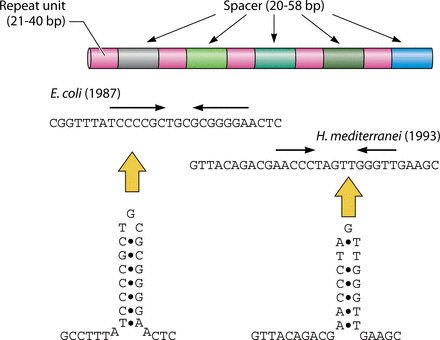B A C K G R O U N D

HISTORY
OF
CRISPR
The first CRISPRs were recognized in Escherichia coli (E. coli) bacteria in 1987 when Japanese scientists, Yoshizumi Ishino and his team, detected unusual repeating sequences in the DNA of the bacterium. The scientists observed that the gene had five short repeating segments of DNA separated by short non-repeating 'spacer' DNA sequences. “The biological significance of these sequences,” they wrote, “is unknown.” After this discovery, Francisco Mojica found that other bacteria and archaea have similar clusters in their DNA, repeating at the core of the tool. He then hypothesized that these clusters are part of the bacteria's immune system, which was later proven to be correct. Thus, the sequences earned the name: Clustered Regularly Interspaced Short Palindromic Repeats or CRISPR. Today, Jennifer Doudna, Emmanuelle Charpentier and Feng Zhang are known as the co-inventors of CRISPR technology due to the new findings that they have shared and published about CRISPR to the fields of science.

WORKS
HOW
CRISPR
CRISPR is found in bacteria's DNA and they are copies of small pieces of viruses. Due to bacteria being very susceptible to viruses, they produce enzymes (special attack enzymes: Cas9) to get rid of viral infections. Whenever these enzymes kill a virus, they store the remains of the virus's genetic code, cut them into tiny pieces, and keep them in CRISPR spaces in the bacterium's genome. These spaces act as a storage room that keeps genetic information and segments of viruses (CRISPR arrays) that the bacteria use to prevent any future attacks from them. Cas9 enzymes carry these viral codes around and when a new viral infection occurs, they scan the virus's RNA to see if there are similarities with the code that they hold. If a match was found, the Cas9 enzyme cuts the virus's DNA to counteract its threat, as shown in the picture.

Cas9 (red)
DNA (yellow)
RNA (blue)
& ITS
FUTURE
Scientists discovered that they can "fool" Cas9 enzymes by binding the enzyme with an artificial RNA that contains a short "guide" sequence, also known as the "short guide RNA" (sgRNA). The Cas9 reacts by searching for the same code that it was provided with, not just viruses, and start cutting, breaking both strands of the DNA molecule. When the cell senses that there is a problem, it repairs the break using a mechanism called the non-homologous end joining (NHEJ) repair pathway, which can disable the gene, repair the mistake, or insert a new trait by providing it with a customized DNA sequence. With this system, undesirable genomes can be cut at any place. Not only that, but scientists can also substitute desired traits into the place that was cut. For example, Cas9 can cut out the gene that causes Cystic Fibrosis and insert a better gene to replace it. The CRISPR/Cas9 system is so precise that Cas9 obliges to whatever a scientist tells it to do and where to do it, which makes it extremely revolutionary. Today, scientists are using CRISPR technology to explore single-gene disorders such as cystic fibrosis, hemophilia, and sickle cell disease. This technology also holds the cure and treatment for more complex diseases such as cancer, muscular dystrophy, HIV infection, mental illnesses, and heart disease.
CRISPR






